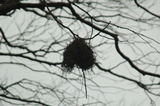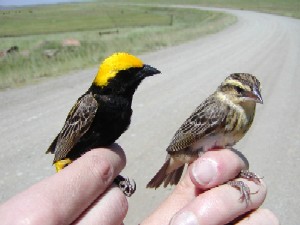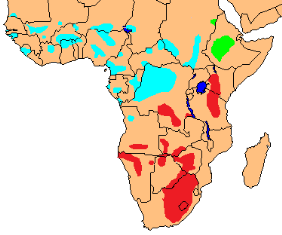Weaver news
|
Today's weaver is the Yellow-crowned Bishop Euplectes afer, one of 17 species in the genus Euplectes. The genus consists of the bishops and widows and they are part of the true weavers subfamily since they also weave their nests (unlike sparrow-weavers and buffalo weavers). Male bishops and widows are black or black with coloured patches of red, orange or yellow. In some species males have long tails. Females, and males in the non-breeding plumage, are dull coloured. Bishops and widows are polygnous and the female incubates the eggs and feeds the chicks. The nest is oval or ball-shaped with a side entrance and is usually well hidden. The Yellow-crowned Bishop feeds mainly on grass seeds and often shows local nomadic movements. It is small with a short tail. The male in breeding plumage is black with golden upperparts other than a black nape band. The width of the nape band and the amount of yellow on the sides of the neck varies in the different subspecies.
The Yellow-crowned Bishop has a patchy distribution spread across sub-Saharan Africa. There are three subspecies:
There is currently one PHOWN record for this species, showing a typical nest (phown 22). The challenge for PHOWNers is to find nests of the Yellow-crowned Bishop, and of other bishop and widow species. Patience is needed, but nest finding is greatly rewarding. Needless to say, care needs to be taken to not disturb nests nor to damage nests while searching for them. See a summary of breeding information for the Yellow-crowned Bishop here. PHOWN records for species Previous Wedn: White-browed Sparrow-Weaver Full species list |













 Displaying males are attractive as they fluff out the yellow feathers on the back while flying over their territories. The nest is an oval ball, built of grass strips and lined with grass seedheads. The nest is supported by vertical grass stalks with a side entrance near the top. The nest is built by the male - the female lines the nest. Nests are well hidden in a tuft of grass, sometimes in bushes, or in rushes and sedges. Nests are usually in waterlogged or flooded areas, <1 m above the ground or water surface. The clutch size is 2-4 (mean 3).
Displaying males are attractive as they fluff out the yellow feathers on the back while flying over their territories. The nest is an oval ball, built of grass strips and lined with grass seedheads. The nest is supported by vertical grass stalks with a side entrance near the top. The nest is built by the male - the female lines the nest. Nests are well hidden in a tuft of grass, sometimes in bushes, or in rushes and sedges. Nests are usually in waterlogged or flooded areas, <1 m above the ground or water surface. The clutch size is 2-4 (mean 3).